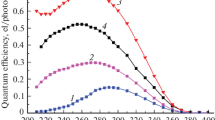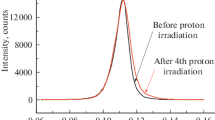Abstract
4H-SiC p+n photodiodes based on ultrathin-junctions have been fabricated with distinct processes for the p+-region creation: either with Aluminium conventional ion implantation, or with Boron Plasma Ion Immersion Implantation. Spectral sensitivity measurements were performed at several temperatures from room temperature up to 340°C, with incident wavelengths ranging from 200 to 400 nm. Both responses are characterized by a stability between 200 and 270 nm, and a important increase with temperature between 270 and 380 nm. This fact has to be related to the two different kinds of optical absorption phenomena in SiC with respect to the wavelength, which are direct and indirect (phonon assisted) transitions. When decreasing the temperature, we noticed a hysteresis effect, which could be due to charge trapping by temperature activated defects. After strong proton and electron irradiations, the diodes showed a stability of the response below 270 nm, making them suitable for use in harsh environments. Simulation was performed at room temperature, with a good correlation between simulated and experimental room temperature curves.
Similar content being viewed by others
References
V. i. Sankin et V. p. Chelibanov, « Silicon Carbide UltravioletPhotodetectors and Their Application in Ecological Monitoring », physica status solidi (a), vol. 185, no 1, p. 153–158, 2001.
S. Biondo, L. Ottaviani, M. Lazar, D. Planson, J. Duchaine, V. Le Borgne, M. A. ElKhakani, F. Milesi, W. Vervisch, O. Palais, et F. Torregrosa, « 4H-SiC P+N UV Photodiodes: A Comparison between Beam and Plasma Doping Processes », Materials Science Forum, vol. 717-720, p. 1203–1206, mai2012.
X. Chen, H. Zhu, J. Cai, et Z. Wua, « High-performance 4H-SiC-based ultraviolet p-i-n photodetector », J. Appl. Phys, vol. 102, no 2, juill. 2007.
S. Biondo, M. Lazar, L. Ottaviani, W. Vervisch, V. Le Borgne, M. A. El Khakani, J. Duchaine, F. Milesi, O. Palais, et D. Planson, « 4H-silicon carbide thin junction based ultraviolet photodetectors », Thin Solid Films, vol. 522, p. 17–19, nov. 2012.
N. Watanabe, T. Kimoto, et J. Suda, « 4H-SiC pn Photodiodes with Temperature-Independent Photoresponse up to 300 degrees C », Appl. Phys. Express, vol. 5, no 9, sept. 2012.
S. Nakagomi, T. Momo, S. Takahashi, et Y. Kokubun, « Deep ultraviolet photodiodes based on β-Ga2O3/SiCheterojunction », Applied Physics Letters, vol. 103, no 7, p. 072105, août 2013.
D. Prasai, W. John, L. Weixelbaum, O. Krüger, G. Wagner, P. Sperfeld, S. Nowy, D. Friedrich, S. Winter, et T. Weiss, « Highly reliable silicon carbide photodiodes for visible-blind ultraviolet detector applications », Journal of Materials Research, vol. 28, no 01, p. 33–37, 2013.
L. Ottaviani, S. Biondo, S. Morata, O. Palais, T. Sauvage, et F. Torregrosa, « Influence of Heating and Cooling Rates of Post-Implantation Annealing Process on Al-Implanted 4H-SiC Epitaxial Samples », Materials Science Forum, vol. 645-648, p. 717–720, avr. 2010.
H. Y. Tada et J. R. Carter, Solar cell radiation handbook. 1977.
B. Chen, Y. Yang, X. Xie, N. Wang, Z. Ma, K. Song, et X. Zhang, « Analysis of temperature-dependent characteristics of a 4H-SiCmetal-semiconductor-metal ultraviolet photodetector », Chin. Sci. Bull, vol. 57, no 34, p. 4427–4433, dec. 2012.
S. Rathgeb, J.-P. Moeglin, A. Boffy M. Pasquinelli, et O. Palais, « Hysteresis phenomena in reverse biased InAsSbP/InAs heterostructure », Applied Physics Letters, vol. 89, no 2, p. 022106–022106–3, juill. 2006.
P. B. Klein, « Identification and carrier dynamics of the dominant lifetime limiting defect in n- 4H-SiC epitaxial layers », physica status solidi (a), vol. 206, no 10, p. 2257–2272, 2009.
T. Kimoto, K. Danno, et J. Suda, « Lifetime-killing defects in 4H-SiC epilayers and lifetime control by low-energy electron irradiation », physica status solidi (b), vol. 245, n° 7, p. 1327–1336, 2008.
C. Cobet, K. Wilmers, T. Wethkamp, N. V. Edwards, N. Esser, et W. Richter, « Optical properties of SiC investigated by spectroscopic ellipsometry from 3.5 to 10 eV », Thin Solid Films, vol. 364, no 1-2, p. 111–113, mars 2000.
S. Zollner, J. G. Chen, E. Duda, T. Wetteroth, S. R. Wilson, et J. N. Hilfiker, « Dielectric functions of bulk 4H and 6H SiC and spectroscopic ellipsometry studies of thin SiC films on Si », Journal of Applied Physics, vol. 85, no 12, p. 8353–8361, juin 1999.
acknowledgments
We thank C. Cobet of the Festkörper Physik Institut, Technische Universität Berlin for providing us his ellipsometric datas.
Author information
Authors and Affiliations
Corresponding author
Rights and permissions
About this article
Cite this article
Bérenguier, B., Ottaviani, L., Biondo, S. et al. 4H-SiC P+N UV Photodiodes: Influence of Temperature and Irradiation. MRS Online Proceedings Library 1693, 1–6 (2014). https://doi.org/10.1557/opl.2014.565
Published:
Issue Date:
DOI: https://doi.org/10.1557/opl.2014.565




